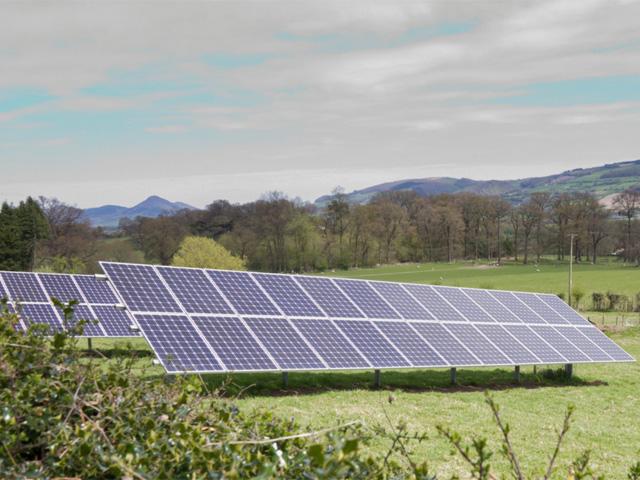REAP Funding Boost Announced
USDA Releases $1 Billion to Incentivize Rural Renewable Energy Grants
OMAHA (DTN) -- Farmers and small rural businesses looking to make their operations more energy efficient or add renewable energy to their farms or businesses now have more funding opportunities with USDA opening $1 billion in grants under the Rural Energy for America Program (REAP), the largest funding expansion in the program's history.
The Biden administration announced the funding availability on Friday with USDA opening a series of quarterly application windows over the next two years for grants as well as a continuous application window for guaranteed loans.
Under the grants announced Friday, USDA will start accepting applications April 1 for the next round of quarterly funds. The new rounds of funding -- boosted through the Inflation Reduction Act (IRA) -- will allow farmers, ranchers and rural businesses to build renewable energy systems and make energy-efficiency improvements.
"Supporting renewable energy and energy-saving systems helps the people of rural America create thriving, livable communities," Agriculture Secretary Tom Vilsack said. "When we invest in rural communities, we are supporting hard work that sends a ripple effect across our country. Clean energy is critical to the future of our economy, and the Inflation Reduction Act provides the Biden-Harris Administration with the resources to build a more prosperous rural America while tackling the climate crisis and lowering energy costs."
Vilsack pointed to some potential energy efficiency changes producers could use on their farms, particularly converting equipment from running on fossil fuels to running on renewable energy sources. Vilsack also gave an example of producers converting irrigation equipment from running on diesel fuel to electric systems. Such energy efficiency projects are eligible for up to $500,000 in funding.
Producers or business owners who want to build renewable energy systems such as wind, solar, biomass, methane digesters, among others can receive up to $1 million for their projects.
USDA also boosted the award levels for REAP projects up to 50% of the total project cost, "especially if greenhouse gas emissions will be reduced," Vilsack said.
To reach smaller producers and businesses and give them "a fair opportunity" to compete for funds, USDA will set aside 20% of the available funds through June 30 each year for grant requests of $20,000 or less.
P[L1] D[0x0] M[300x250] OOP[F] ADUNIT[] T[]
In its news release, USDA cited that the department "is particularly interested in REAP projects that will help rural communities recover economically through more and better market opportunities and improved infrastructure, reduce climate pollution and increase resilience to the impacts of climate change, conserve and protect farmland, and invest in underserved communities." Another provision will ensure that as much as 40% of the overall benefits will go to Tribes, underserved, disadvantaged communities and areas of the country that are "overburdened by pollution."
To lower emissions, REAP also will have $144.5 million of the funds go to "underutilized technologies" that are classified as those "which do not produce greenhouse gases at the project level." Vilsack said the funding for underutilized technologies would "make sure we leave no technology behind."
USDA will hold quarterly grant competitions through Sept. 30, 2024.
WHO QUALIFIES?
REAP is set up specifically to help farmers and small rural businesses.
To be defined as a "farmer," producers must show that at least 50% of their gross income is from their agricultural operations.
For small rural businesses, they generally must be located in a community with fewer than 50,000 people. Businesses located in more urban areas can qualify if they can show their business is related to a rural area. Businesses must also meet the definition of "small" with net worth under $15 million and net income under $5 million annually for the previous two years.
A small business can also include a cooperative, a rural electric utility or a tribal corporation.
The funding notice also has specific details about eligibility for operations that grow, process or sell hemp products, including verification of valid hemp licenses.
REAP APPLICATIONS ARE SCORED
Applications are scored on a set of criteria, one of which provides 10 points for application requests under $250,000.
Other scoring for a project includes points based on the percentage of energy that would be replaced by the project. For instance, projects that do not produce greenhouse gas emissions will be awarded up to 10 points. Other points can be rewarded for other environmental benefits cited on the project. Other points are scored based on the payback of energy savings, as well as the commitment of funds for the project.
Veterans, socially disadvantaged applications or projects in disaster areas or U.S. Census blocks with high poverty rates also receive additional points added to their applications.
USDA Rural Development Energy Programs https://www.rd.usda.gov/…
USDA Federal Register notice: https://www.govinfo.gov/…
Chris Clayton can be reached at Chris.Clayton@dtn.com
Follow him on Twitter @ChrisClaytonDTN
(c) Copyright 2023 DTN, LLC. All rights reserved.




